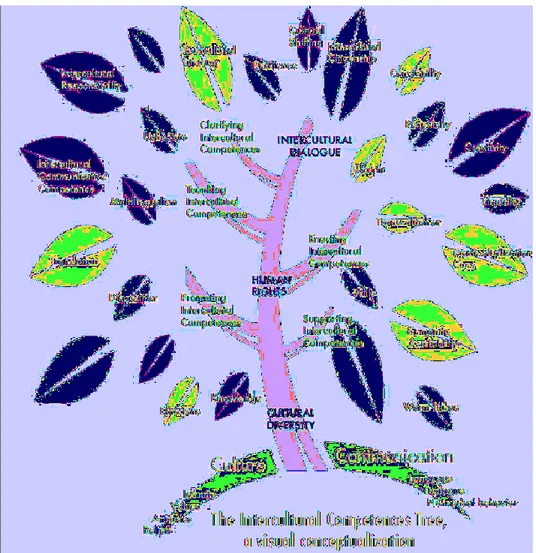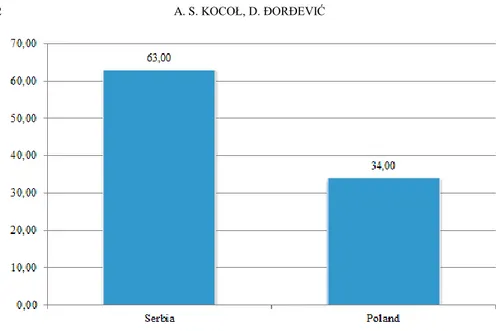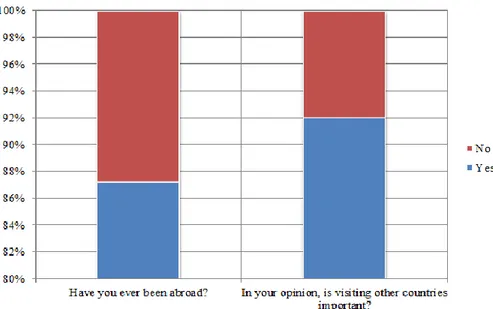UDC: (811.111‟276+347.441.11):371.214.18 DOI: 10.22190/JTESAP1702367S
INTERCULTURAL COMPETENCE OF ESP STUDENTS
Anna Stefanowicz-Kocoł1, Danijela Đorđević2 1The State Higher Vocational School in Tarnów Phone: + 48 14 63 16 600, E-Mail: anna.kocol@gmail.com
2University of Belgrade, Faculty of Agriculture, Belgrade Phone: + 381 64 284 38 06, E-Mail: dani.djordje@gmail.com
Abstract. Bearing in mind the importance of international communication, globalisation, student mobility and employability, the readiness to use language properly in different social and cultural contexts has become a major priority. It comprises a wide array of skills that make up what is known as intercultural competence. It might be defined as a set of abilities and qualities necessary for understanding of and communication with other people, no matter whether they come from different countries or not. This paper aims to investigate the understanding of and attitudes to intercultural competence of ESP students in Poland and Serbia. Since we live in the age of globalisation, it seems it ought to be quite important for all students to become interculturally competent. Therefore, we also attempted to analyse various factors influencing students’ attitudes such as their national background or experience abroad. The results present a set of issues to be addressed by ESP teachers, as well as similarities and differences observed for Polish and Serbian ESP students. The implications for further research as well as limitations of this study are stated.
Key words: intercultural competence, ESP
1. INTRODUCTION
Intercultural competence is a fresh construct. With the onset of globalization and increased mobility of representatives of practically all cultures of the world the distinct features that these cultures have come to be acknowledged. For some their diversity has been the driving force for actions aimed at preserving them in an unchanged form and appreciating them as they are. For others, the differences among cultures have been a concern as they were said to be the reason for difficulties in communication in multinational classrooms, workplaces, scientific conferences or political meetings. In the area of ESP teaching, as well as teaching foreign languages in general, the issue has been receiving much attention recently. A lot is also being said about the way it should be approached. The question we attempted to answer in our research was what the problem looks like in our ESP classes and what factors influence it.
2. DEFINING THE TERMS
Although a lot has been written on this competence, a comprehensive definition of the concept cannot be provided. This competence is somehow closely connected to intercultural communication which is referred to as „communication between people with different cultural backgrounds‟ (Chi 2015), comprising three important elements: „contact (communication) between different cultures (inter-), and the cultural differences should make a difference in the process‟. In other words, contact, different cultures and cultural differences are of great significance when it comes to intercultural communication. It is observed that both the medium (e.g. email, social media, face to face), and cultural differences (including e.g. nationality, ethnicity, religious belief, gender, age/generation, geographical region, political ideology, body (dis)ability, sexual orientation, etc.), make a difference in the process of communication (Chi 2015). Therefore, it is assumed that almost every interaction may be identified as intercultural if there are some cultural factors that differentiate the participants of an act of communication (Chi 2015).
The question that arises here is whether we may look at any communication in the classroom as at intercultural communication bearing in mind that students do come from different backgrounds, religious beliefs, gender, age, geographical region, sexual orientation, etc. Byram (1997, 70-71) makes a difference between intercultural competence and intercultural communication competence, claiming that in case of intercultural competence, individuals are able to communicate in their own language with people from other countries and cultures, whereas in the case of intercultural communication competence they can interact with people from other countries in a foreign language. However, later on Byram et al. (2002, 5) defined intercultural competence as the „ability to ensure a shared understanding by people of different social identities, and their ability to interact with people as complex human beings with multiple identities and their own individuality‟.
For the purpose of this paper we shall adhere to intercultural competence understood as “the ability to develop targeted knowledge, skills and attitudes that lead to visible behaviour and communication that are both effective and appropriate in intercultural interactions” (Deardorff , D.K. 2009, 242). Since the definition refers to the terms „culture‟ and „intercultural‟, we understand culture as defined by Herbig (1998, 17) who sees it as “the sum of a way of life, including expected behaviour, beliefs, values, language and living practices shared by members of a society. It consists of both explicit and implicit rules through which experience is interpreted”. It was also concisely summarized by Geert Hofstede (2001, 24), as a “programming of the mind”. Communication in this research is concerned with all forms of sending, decoding and interpreting messages, whose meaning is dependent on co-construction of the underlying sense by all the interlocutors involved (Galanes & Leeds-Hurwitz, 2009).
3. AN INTERCULTURALLY COMPETENT PERSON
an ability to communicate with people in a way that earns their respect and trust, thereby encouraging a cooperative and productive workplace that is conducive to the achievements of professional or assignment goals;
the capacity to adapt his/her professional skills (both technical and managerial) to fit local conditions and constraints; and
the capacity to adjust personally so that s/he is content and generally at ease in the host culture.
Unlike earlier models and skills classifications, IEP also includes a list of skills and personal attributes of interculturally effective persons:
adaptation skills
attitude of modesty and respect
understanding of the concept of culture
knowledge of the host country and culture
relationship-building
self-knowledge
intercultural communication
organizational skills
personal and professional commitment.
Deardorff (2011) draws conclusions on the basis of five regional reports prepared for UNESCO (Dragićević Šešić & Dragojević, 2009; Grimson, 2011; Holmes, 2009; Steyn, 2009; Youssef, 2011). She puts together a list of skills and competences which appear to be the most necessary to attain intercultural competence:
Respect (“valuing of others”);
Self-awareness/identity (“understanding the lens through which we each view the world”);
Seeing from other perspectives/world views (“both how these perspectives are similar and different”);
Listening (“engaging in authentic intercultural dialogue”);
Adaptation (“being able to shift temporarily into another perspective”);
Relationship building (forging lasting cross-cultural personal bonds);
Cultural humility (“combines respect with self-awareness”).
Whichever authority we might want to adhere to, it is clearly visible that a culturally competent person ready to undertake any intercultural communication in the classroom needs to be a confident yet flexible person, aware of their own identity and of the possible areas where the identities of other participants of interaction might differ. What seems indispensable as well is the willingness to respect the differences and an ability to instill the same spirit in their interlocutors. The success of an interaction is always dependent on both (or all) sides of the interaction, so it is important to bear in mind that the above mentioned qualities need to be nurtured in every society.
4 THE COMPLEXITY OF INTERCULTURAL COMPETENCE
dialogue accompanied by cultural diversity and human rights stemming from them and constituting the main trunk of the tree. Then come various activities that need to be undertaken to ensure that the issues mentioned above get to be enacted in real life: clarifying, teaching, promoting, supporting and enacting intercultural competences. It is thanks to these actions that we can eventually observe all the desirable phenomena listed on the leaves, e.g.: intercultural responsibility, intercultural literacy, cultural shifting, intercultural citizenship, conviviality, creativity, liquidity, contextualization cues, multilingualism, disposition, emotions, knowledge, intercultural communicative competence. Some of the leaves are still empty as intercultural competence, just like a tree, is a living and changing construct that keeps adjusting to and incorporating constantly emerging contexts worldwide.
5. PROBING INTERCULTURAL COMPETENCE OF ESP STUDENTS
Being as complex as described above, intercultural competence is hard to be assessed. However, researchers have been trying to develop instruments that assessed it in various contexts (Sinicrope et al. 2007, 24, Fantini, 2000, 2006). Fantini (2006, 12) proposed the definition of intercultural competence as “a complex of abilities needed to perform effectively and appropriately when interacting with others who are linguistically and culturally different from one‟s self”. On the basis of the definition, Fantini listed the following components: characteristics of intercultural competence, domains of intercultural competence (relationships, communication, and collaboration), dimensions of intercultural competence (knowledge, attitude, skills, and awareness), language proficiency, and developmental level. However, concluding his research, Fantini (2009, 464) admits, that “assessing intercultural competence also requires using a variety of different techniques and strategies”. He hives possible examples of such instruments
Closed and open-ended questions
Objective strategies that involve scoring (e.g., matching items, true/false questions, multiple-choice questions, cloze or gap-filling items)
Oral and written activities (e.g., paraphrasing, translation, essay)
Active and passive activities
Individual and interactive activities in pairs or groups
Dialogue, interviews, debate, and discussion
Demonstrations, poster sessions, role-plays, and simulations
Structured and unstructured field tasks and experiences
Questionnaires that require self-evaluation, peer evaluation, group evaluation, and/or teacher evaluation.
Deardorff (2009, 477) wonders whether, given the variety of the contexts where the assessment could take place, assessment of intercultural competences is practically feasible: “Can intercultural competence be assessed? This question generates a variety of responses, including from those who feel it is simply not possible to assess intercultural competence.” The answer at which he arrives in the end is positive. He warns, however that we need to adjust the tools and methods to our context and our definition of the construct.
5.1. The study
Figure 2 The country of origin
5.2. Findings and discussion
As for gender, the distribution was almost equal in both groups with female participants constituting a slight majority (54%) in case of Serbian respondents and a vast majority (85%) among Polish ones (see Figures 3 and 4). The difference is due to the fact that the majority of Polish respondents come from the Nursing Department which has a very small population of male students.
Figure 4 Gender of Polish respondents
Regarding the age of the respondents, we see that the Serbian respondents were generally younger than their Polish counterparts (See Figure 5). It results from the fact that the survey was carried out among first year students in Serbia and among second and third year students in Poland.
Figure 5 Age of respondents
Figure 6 Polish respondents‟ attitudes towards going abroad and importance of visiting foreign countries
Figure 7 Serbian respondents‟ attitudes towards going abroad and importance of visiting foreign countries
Figure 8 Polish respondents‟ attitudes towards cultural differences and where they can be observed
Regarding the questions on cultural differences and where they can be observed, we noticed various answers. Interestingly, in both groups the highest scores are observed in answers to questions concerning judgments and values as well as prejudices and stereotypes. As can be seen from Figures 8 and 9, Polish respondents have answered these questions very high (85%) Serbian respondents scored slightly lower here with 77% for prejudices and stereotypes and 85% for judgments and values. The lowest scores were noticed for non verbal symbols in case of Serbian respondents and for written communication in case of Polish respondents. The latter also do not think grammar is an area where cultural differences could be observed.
5. CONCLUSIONS
As it can be seen for the data gathered, students, regardless of the age, gender and country of origin, perceive cultural differences as an issue. They expect to encounter them in a number of areas in everyday life and clearly connect them with a foreign language as both of the groups scored high on Vocabulary being an area where cultural differences are observable. They demonstrated that they see the importance of travelling abroad and finding out about other cultures, but they hardly associated their journeys with getting to know the culture of the foreign country. On the one hand, it is positive information for us as teachers of English for Specific Purposes - we have managed to make our students aware that they should expect differences among cultures. On the other hand, there seems to be an urgent need to introduce a systemic approach showing our students where exactly the differences may be expected and how to deal with them so they could feel confident working or living in a multinational community in the future.
R
EFERENCESBennet, Milton. “Developmental Model of Intercultural Sensitivity (DMIS)” url: http://www.idrinstitute.org/page.asp?menu1=15 accessed 17 March 2017
Chi, Ruobing B. 2015. “What is intercultural Communication?” The SISU Intercultural
Institute Intercultural Communication FutureLearn course reading. Url:
https://www.futurelearn.com/courses/intercultural- communication/ accessed 17 March 2017
Deardorff, Darla K. 2006. “The Identification and Assessment of Intercultural Competence as a Student Outcome of Internationalization at Institutions of Higher Education in the United States.” Journal of Studies in International Education 10:241-266
Deardorff, Darla K. 2008. “Intercultural Competence: A Definition, Model and Implications for Education Abroad.” In Developing Intercultural Competence and Transformation: Theory, Research, and Application in International Education, edited by: Victor Savicki. pp. 32-52. Sterling, VA: Stylus.
Deardorff, Darla K. 2009. “Implementing Intercultural Competence Assessment.” In The SAGE Handbook of Intercultural Competence, ed. Darla K. Deardorff. pp. 477-491. Thousand Oaks, CA: Sage.
Deardorff, Darla K. 2010. A Comparative Analysis and Global Perspective of Regional
Studies on Intercultural Competence. Paris: UNESCO
Deardorff , Darla K. 2011. Promoting understanding and development of intercultural dialogue and peace: A comparative analysis and global perspective of regional studies on intercultural competence. Report of the State of the Arts and Perspectives on Intercultural Competences and Skills, UNESCO.
Internationalization at Institutions of Higher Education in the United States, Journal of Studies in International Education 10:241-266
Galanes, G., & W. Leeds-Hurwitz, (Eds.). 2009. Socially constructing communication. Cresskill, NJ: Hampton Press.
Herbig, P. 1998 Handbook of Cross-Cultural Marketing, New York: The Haworth Press Hofstede, G. 1991/1997. Cultures and organizations: software of the mind. London :
McGraw-Hill.
Hofstede, G. 2001. Culture’s Consequences: International Differences in Work-Related
Values, London: Sage
Kealey D.J. 1990. Cross-Cultural Effectiveness - A Study of Canadian Technical Advisors
Overseas. Quebec : Canadian International Development Agency.
A Profile of the Interculturally Effective Person. 2000. Centre for Intercultural Learning, Department of Foreign Affairs and International Trade. Canada.




